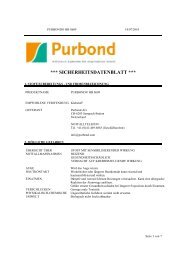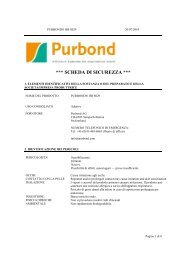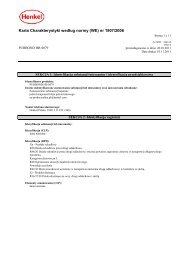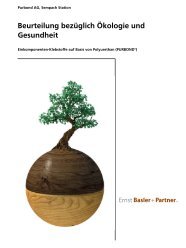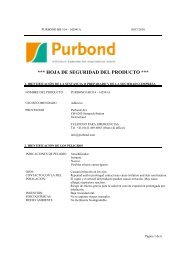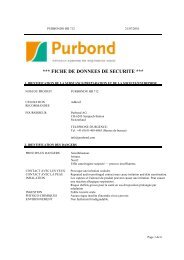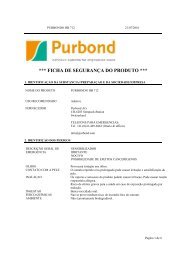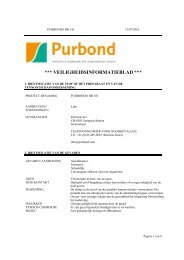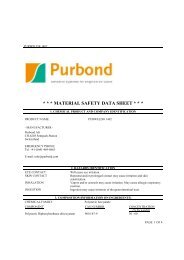MATERIAL SAFETY DATA SHEET
MATERIAL SAFETY DATA SHEET
MATERIAL SAFETY DATA SHEET
You also want an ePaper? Increase the reach of your titles
YUMPU automatically turns print PDFs into web optimized ePapers that Google loves.
PURWELD® 1202 Print date: 11-February-2010<br />
*** <strong>MATERIAL</strong> <strong>SAFETY</strong> <strong>DATA</strong> <strong>SHEET</strong> ***<br />
1. CHEMICAL PRODUCT AND COMPANY IDENTIFICATION<br />
PRODUCT NAME: PURWELD® 1202<br />
liquid adhesive for bonding wood<br />
COMPANY ADDRESS Purbond AG<br />
CH-6203 Sempach-Station<br />
Switzerland<br />
2. HAZARDS IDENTIFICATION<br />
EMERGENCY OVERVIEW<br />
EMERGENCY PHONE:<br />
+41-(0)41-469-6863<br />
info@purbond.com<br />
WARNING.<br />
Respiratory irritant.<br />
EYE IRRITANT.<br />
RESPIRATORY SENSITIZER.<br />
SKIN SENSITIZER.<br />
Tan Liquid Negligible Odor<br />
EYE Will cause eye irritation.<br />
SKIN CONTACT Repeated and/or prolonged contact may cause irritation and skin sensitization.<br />
INHALATION Vapors and/or aerosols may cause irritation May cause allergic respiratory<br />
reaction.<br />
INGESTION Ingestion may cause irritation of the gastrointestinal tract.<br />
3. COMPOSITION/INFORMATION ON INGREDIENTS<br />
CHEMICAL FAMILY Polymeric Isocyanate<br />
COMPONENT CAS NUMBER CONCENTRATION<br />
PAGE 1 OF 6
PURWELD® 1202 Print date: 11-February-2010<br />
(% by weight)<br />
Polymeric Diphenylmethane diisocyanate 9016-87-9 30 - 60<br />
4. FIRST-AID MEASURES<br />
EYE Irrigate with eyewash solution or clean water until pain is relieved.<br />
SKIN CONTACT Wash skin with soap and water.<br />
INHALATION Remove to fresh air. If breathing is difficult, give oxygen. If breathing has<br />
stopped, give artificial respiration. Get medical attention.<br />
INGESTION Treat symptomatically and supportively. Get medical attention.<br />
5. FIREFIGHTING MEASURES<br />
AUTOIGNITION Not available<br />
FLASH POINT > 200 °C (Pensky-Martens Closed Tester)<br />
EXTINGUISHING MEDIA CO2; Dry Chemical; Foam<br />
SPECIAL FIREFIGHTING PROCEDURES Fire fighters should be equipped with self-contained<br />
breathing apparatus to protect against potentially toxic and<br />
irritating fumes.; Cool exposed equipment with water<br />
spray.<br />
FIRE & EXPLOSION HAZARDS Combustion will evolve toxic and irritant vapors.<br />
HAZARDOUS COMBUSTION PRODUCTS Decomposes upon heating to release toxic fumes of<br />
nitrogen oxides, carbon monoxide, carbon dioxide, and<br />
hydrogen cyanide.<br />
LOWER EXPLOSION LIMIT (%) Not applicable<br />
UPPER EXPLOSION LIMIT (%) Not applicable<br />
6. ACCIDENTAL RELEASE MEASURES<br />
SPILL AND LEAK PROCEDURES Allow to cool and solidify. Scrape up and collect in suitable containers for<br />
disposal. Ventilate area.<br />
For safety and environmental precautions, please review entire Material Safety Data Sheet for necessary<br />
information.<br />
7. HANDLING AND STORAGE<br />
STORAGE TEMPERATURE Room<br />
HANDLING/STORAGE Store at room temperature. Product contains<br />
hazardous volatile ingredients which could<br />
accumulate in the unvented headspace of drums or<br />
bulk storage vessels. Open drums in ventilated area.<br />
Avoid breathing vapors.<br />
SENSITIVITY TO STATIC ELECTRICITY No<br />
SPECIAL SENSITIVITY Avoid moisture contamimation.<br />
SENSITIVITY TO MECHANICAL IMPACT No<br />
8. EXPOSURE CONTROLS/PERSONAL PROTECTION<br />
COMPONENT EXPOSURE LIMITS<br />
PAGE 2 OF 6
PURWELD® 1202 Print date: 11-February-2010<br />
Polymeric Diphenylmethane<br />
diisocyanate<br />
ACGIH OSHA Mfg Working<br />
Standard<br />
0.005 ppm TWA. 0.02 ppm Ceiling; 0.2<br />
mg/m3 Ceiling<br />
EXPOSURE LIMIT NOTES Exposure limits for Polymeric Diphenylmethane diisocyanate are<br />
based on the limits set for the monomeric form (101-68-8).<br />
VENTILATION REQUIREMENTS Local exhaust to keep vapors below TLV.<br />
EYE PROTECTION REQUIREMENTS Safety glasses, goggles or face shield to protect against splashing.<br />
GLOVE REQUIREMENTS Employee must wear appropriate protective gloves to prevent contact with<br />
this substance.<br />
CLOTHING REQUIREMENTS Appropriate protective clothing and equipment is recommended to<br />
minimize skin contact with this substance.<br />
CHANGE/REMOVAL OF CLOTHING Remove contaminated clothing and launder before reuse.<br />
WASH REQUIREMENTS Wash before eating, drinking, or using toilet facilities.<br />
RESPIRATOR REQUIREMENTS NIOSH approved respirator if required. Self-contained breathing<br />
apparatus in emergency and non-routine situations.<br />
9. PHYSICAL AND CHEMICAL PROPERTIES<br />
PURE SUBSTANCE OR MIXTURE Mixture<br />
PHYSICAL FORM Liquid<br />
COLOR Tan<br />
ODOR Negligible<br />
ODOR THRESHOLD Not available<br />
PH AS IS Not applicable<br />
pH IN (1%) SOLUTION Not applicable<br />
OXIDIZING PROPERTIES Not applicable<br />
BOILING POINT Not applicable<br />
MELTING/FREEZING POINT Not available<br />
SOLUBILITY IN WATER Insoluble<br />
PARTITION COEFFICIENT (n-octanol/water) Not applicable<br />
BULK DENSITY 9.16 lb/gal<br />
EVAPORATION RATE Not applicable<br />
VAPOR PRESSURE (mmHg) Not available<br />
VAPOR DENSITY (air = 1) N/A<br />
VOLATILES None<br />
VOLATILE ORGANIC COMPOUNDS 10 g/liter<br />
AUTOIGNITION Not available<br />
FLASH POINT > 200 °C (Pensky-Martens Closed Tester)<br />
10. STABILITY AND REACTIVITY<br />
STABILITY Stable<br />
HAZARDOUS DECOMPOSITION PRODUCTS Decomposes upon heating to release toxic fumes of nitrogen<br />
oxides, carbon monoxide, carbon dioxide, and hydrogen<br />
cyanide.<br />
PAGE 3 OF 6
PURWELD® 1202 Print date: 11-February-2010<br />
11. TOXICOLOGICAL INFORMATION<br />
ROUTE OF ENTRY Inhalation; Ingestion; Skin Contact; Eye Contact<br />
CARCINOGEN IARC<br />
(group)<br />
COMPONENT<br />
There is no evidence that<br />
this product poses a<br />
carcinogenic risk under<br />
normal conditions of<br />
handling and use.<br />
ACUTE (SHORT TERM) EFFECTS OF EXPOSURE<br />
NTP OSHA Substance<br />
Specific Regulation<br />
CHRONIC (LONG TERM) EFFECTS OF EXPOSURE<br />
EFFECTS OF CHRONIC EXPOSURE The toxicological properties of this product have not been<br />
fully evaluated. Use of good industrial hygiene practices is<br />
required. Avoid direct contact with skin or eyes. Do not<br />
ingest or inhale.<br />
TARGET ORGANS Respiratory system; Skin; Eyes; Lungs; Gastrointestinal<br />
RESPIRATORY SENSITIZATION Sensitizer. May cause allergic reaction.<br />
SKIN SENSITIZATION Sensitizer. May cause allergic reaction.<br />
COMPONENT ORAL TOXICITY NOTES ON ORAL TOXICITY<br />
Polymeric<br />
Oral LD50: Rat > 15000 Irritant and may cause nausea and vomiting.<br />
Diphenylmethane<br />
diisocyanate<br />
mg/kg<br />
COMPONENT DERMAL TOXICITY NOTES ON DERMAL TOXICITY<br />
Polymeric<br />
Diphenylmethane<br />
diisocyanate<br />
Dermal LD50: Rabbit ><br />
5000 mg/kg<br />
Irritating to the skin. Repeated and/or prolonged<br />
contact may cause skin sensitization.<br />
COMPONENT INHALATION TOXICITY NOTES ON INHALATION TOXICITY<br />
Polymeric<br />
Diphenylmethane<br />
diisocyanate<br />
Inhalation LC50 (4hr): Rat<br />
490 mg/m3<br />
Respiratory irritant. Respiratory sensitizer.<br />
Extremely toxic. Exposure to high concentrations<br />
may produce lung damage. Symptoms may include<br />
irritation to the eyes, nose, throat and lungs, possibly<br />
combined with dryness of the throat, tightness of<br />
chest and difficulty in breathing. Symptoms may<br />
develop after several hours.<br />
PAGE 4 OF 6
PURWELD® 1202 Print date: 11-February-2010<br />
COMPONENT NOTES ON EYE IRRITATION<br />
Polymeric<br />
Will cause eye irritation.<br />
Diphenylmethane<br />
diisocyanate<br />
12. ECOLOGICAL INFORMATION<br />
POTENTIAL TO BIOACCUMULATE Unknown.<br />
AQUATIC TOXICITY None Established<br />
13. DISPOSAL CONSIDERATIONS<br />
WASTE DISPOSAL METHODS Disposal should be in accordance with local, state or national legislation.<br />
EMPTY CONTAINER WARNINGS Empty containers may contain product residue; follow MSDS and label<br />
warnings even after they have been emptied.<br />
14. TRANSPORTATION INFORMATION<br />
This section provided for general information only. The shipping description below may not represent<br />
requirements for all modes of transportation, packaging, shipping methods or locations outside of the United<br />
States.<br />
FOR MORE COMPLETE TRANSPORTATION REGULATORY INFORMATION PLEASE REFER TO THE<br />
SHIPPING DOCUMENTS ACCOMPANYING THE SHIPMENT OF THIS PRODUCT.<br />
DOT CLASSIFICATION Not regulated<br />
The information provided herein may not include the impact of additional regulatory requirements (eg, for<br />
materials meeting the definition of a hazardous waste under RCRA, hazardous substances under CERCLA, and/of<br />
marine pollutants under CWA or other similar federal, state or local laws) or any associated exceptions or<br />
exemptions under regulations applicable to the transport of this material.<br />
15. REGULATORY INFORMATION<br />
USA<br />
TSCA This product is manufactured in compliance with all provisions of the<br />
Toxic Substances Control Act, 15 U.S.C. 2601 et. seq.<br />
SARA - Section 313 (Superfund Amendments and Reauthorization Act of 1986 - 40CFR 372)<br />
CAS NUMBER CONCENTRATION<br />
(% by weight)<br />
Polymeric diphenylmethane diisocyanate 9016-87-9 47.481<br />
CALIFORNIA PROPOSITION 65<br />
WARNING: This product contains the following chemicals that are known to the State of California to cause<br />
cancer, birth defects or other reproductive harm.<br />
PAGE 5 OF 6
PURWELD® 1202 Print date: 11-February-2010<br />
Unless a concentration is specified in Section 2 of the MSDS, the below chemical/s are present in trace<br />
amounts.<br />
COMPONENT CAS NUMBER<br />
None reportable.<br />
16. OTHER INFORMATION<br />
HMIS® Hazard Ratings<br />
HMIS® ratings are based on a 0-4 rating scale, with 0 representing minimal hazards or risks, and 4 representing<br />
significant hazards or risks. Although HMIS® ratings are not required on MSDSs by OSHA's 29 CFR 1910.1200,<br />
we choose to provide them as a service to our customers using HMIS®. These ratings are to be used only with a<br />
fully implemented HMIS® program. To deal adequately with the safe handling of this material, all the<br />
information contained in this MSDS must be considered.<br />
NPCA recommends that employers must determine appropriate PPE for the actual conditions under which this<br />
product is used in their workplace. For information on PPE codes, consult the HMIS® Implementation Manual.<br />
When two ratings are provided for Health, the first represents the material 'as supplied', and the second represents<br />
the material 'in use'.<br />
* = chronic health hazard<br />
HMIS® is a registered trademark of the National Paint and Coatings Association (NPCA).<br />
Health Flammability Reactivity<br />
2 1 1<br />
MSDS DATE 11-February-2010<br />
FOR INFORMATION CONTACT: Regulatory Affairs<br />
ADDITIONAL INFORMATION: The information given and the recommendations made herein apply to our<br />
product(s) alone and are not combined with other product(s). Such are based on our research and on data from<br />
other reliable sources and are believed to be accurate. No guaranty of accuracy is made. It is the purchaser's<br />
responsibility before using any product to verify this data under their own operating conditions and to determine<br />
whether the product is suitable for their purposes.<br />
PAGE 6 OF 6



